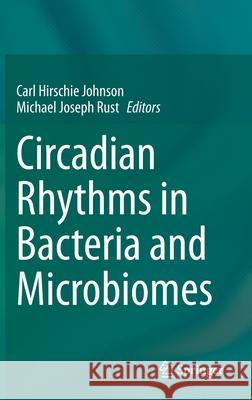Circadian Rhythms in Bacteria and Microbiomes » książka



Circadian Rhythms in Bacteria and Microbiomes
ISBN-13: 9783030721572 / Angielski / Twarda / 2021 / 415 str.
Circadian Rhythms in Bacteria and Microbiomes
ISBN-13: 9783030721572 / Angielski / Twarda / 2021 / 415 str.
(netto: 764,96 VAT: 5%)
Najniższa cena z 30 dni: 771,08
ok. 22 dni roboczych
Dostawa w 2026 r.
Darmowa dostawa!
Carl Hirschie Johnson earned his B.A. at the University of Texas, followed by graduate work with Colin Pittendrigh, a pioneer of chronobiology, at Stanford University. A postdoctoral fellowship with the clocks and bioluminescence expert J. Woodland (‘Woody’) Hastings at Harvard University completed his training. Johnson is now Cornelius Vanderbilt Professor of Biological Sciences at Vanderbilt University, and his laboratory studies circadian biological clocks from perspectives ranging from molecules (biochemistry and biophysics) to populations (evolution and adaptive fitness). He served as President of the Society for Research on Biological Rhythms (SRBR), the major international society of chronobiologists in 2012-2014.
This book addresses multiple aspects of biological clocks in prokaryotes.
The first part of the book deals with the circadian clock system in cyanobacteria, i.e. the pioneer of bacterial clocks. Starting with the history and background of cyanobacteria and circadian rhythms in microorganisms, the topics range from the molecular basis, structure and evolution of the circadian clock to modelling approaches, Kai systems in cyanobacteria and biotechnological applications.
In the second part, emergent timekeeping properties of bacteria in microbiomes and bacteria other than cyanobacteria are discussed.
Since the discovery of circadian rhythms in cyanobacteria in the late 1980s, the field has exploded with new information. The cyanobacterial model system for studying circadian rhythms (Synechococcus elongatus), has allowed a detailed genetic dissection of the bacterial clock due to state-of-the-art methods in molecular, structural, and evolutionary biology. Cutting-edge research spanning from cyanobacteria and circadian phenomena in other kinds of bacteria, to microbiomes has now given the field another major boost.
This book is aimed at junior and senior researchers alike. Students or researchers new to the field of biological clocks in prokaryotes will get a comprehensive overview, while more experienced researchers will get an update on the latest developments.
1997-2025 DolnySlask.com Agencja Internetowa
KrainaKsiazek.PL - Księgarnia Internetowa









